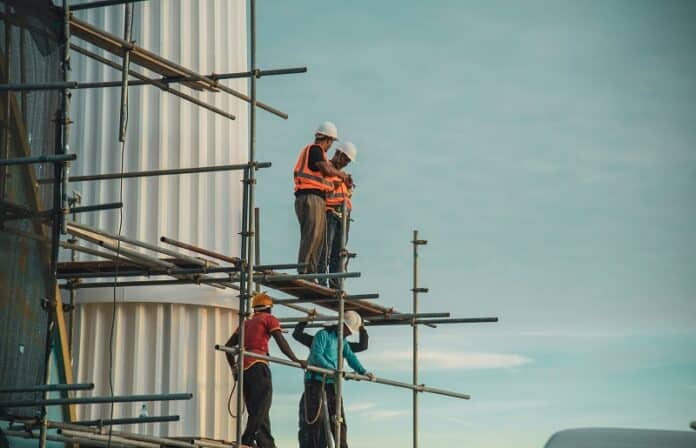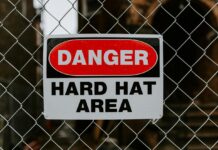Construction sites are known for having various hazards present that can potentially cause harm to workers’ health. These threats can range from minor to major, depending on the type of risk they pose to the people at the construction site. According to health and safety regulations, employers are primarily responsible for implementing workplace health and safety policies and providing their staff with a healthy and secure environment. However, it is greatly important to take effective control measures against these hazards in the workplace to ensure the well-being of employees and people in the workplace. For your idea, in this blog, we will explain to you the top five most common and dangerous hazards present at a construction site.
Top five hazards
1) Falls
Falls at a construction site can occur due to many reasons. It can either be due to slips and trips from objects in the pathway or due to working at heights or confined spaces. However, falls are one of the main causes of injury and death at construction sites. According to the Occupational Safety and Health Administration (OSHA), “falls are the leading cause of death in the construction industry”, accounting for approximately one-third of all fatalities. As this fact states, falls at a construction site are fatal, and therefore it is important that effective measures are put in place to reduce the risk of falling at a construction site.
To prevent slips and trips, it is important that employee keep their workplace clean and tidy and proof of all objects that could cause slips and trips. Installing guardrails in slope areas at a construction site can be an appropriate solution to reduce slips and trips.
Fall arrest systems should be installed in those workplaces where work at height is frequently performed. One of the key solutions to prevent falls from height could be the provision of working at height training. Responsible supervisors or employers should provide their staff with working at height training to ensure that the worker is able to effectively conduct their task at height and ensure their safety. Provision of training is one of the most effective health and safety policy and under most of the laws, employers are legally obliged to provide their employees with appropriate training to ensure their safety.
2) Struck by incidents
With many tasks being performed at a construction site, struck by incidents can be a common hazard in the workplace. This includes the workers being struck by moving vehicles, machines, or objects. According to OSHA, struck-by incidents are the second leading cause of death in the construction industry, with an average of 80 fatalities and over 11,000 non-fatal injuries each year. Therefore, these incidents can cause serious injuries or even deaths.
To prevent injuries and accidents from being struck by moving objects, it is important to use barriers, warning signs, and personal protective equipment. Barriers would allow the workers to work in their own respective areas and not go into other areas where different kinds of work are being conducted, thus reducing the chances of the incident. Signs would help workers to stay alert of moving objects and ensure their well-being.
3) Electrocution
Electrical hazards are a significant danger at construction sites. Most of the processes are conducted on a construction site that is powered by electricity. Therefore, these increase the chances of electrical hazards if proper safety is not maintained. According to OSHA, electrocution is the fourth leading cause of death in the construction industry, with an average of 71 fatalities and over 300 non-fatal injuries each year. To prevent electrocution, it is important to provide proper training on safe work practices and the use of insulated tools and equipment. Employers are also responsible for carrying out tests on electrical appliances on the construction site; this would help them detect possible faults such as electric leaks and faults in those appliances. By identifying the faults, employers can repair these machines, reducing the chances of accidents from electrocution and downtime.
4) Asbestos and chemical hazards
Construction sites can expose workers to various dangerous chemicals and biological hazards. Exposure to asbestos, mould, and other substances can cause serious health problems. Workers operating at construction sites, especially those older ones, could be exposed to asbestos fibres that could seriously harm their health. Asbestos inhalation can cause asbestosis and can be lethal. Therefore, workers should be aware of asbestos-containing fibres that can be present on the construction site. One appropriate solution can be asbestos awareness training, which would educate the employees on identifying asbestos-containing materials and ensuring their safety while being exposed to it.
The use of proper PPE should be made compulsory so that employees can ensure their well-being while handling hazardous and chemical substances at a construction site. Also, employers should install ventilation so that fumes and chemical gasses are not stored in one area for a long time.
5) Caught in between incidents
According to OSHA, caught-in or between incidents are the third leading cause of death in the construction industry, with an average of 50 fatalities and over 2,000 non-fatal injuries yearly. Many of these incidents involve heavy equipment, such as excavators, backhoes, and bulldozers. Caught-in or between incidents occur when workers are caught or crushed between heavy equipment or materials. These incidents can cause serious injuries or death.
To prevent such incidents, workers should follow all the procedures told to them to ensure their safety. Also, training would allow workers to identify potential hazards and take appropriate precautions. Regular maintenance and equipment inspections can help identify potential hazards and prevent accidents.
Conclusion
In conclusion, construction sites are inherently dangerous places to work. However, by taking appropriate precautions and following established safety guidelines, workers can reduce the risk of accidents and injuries. Employers are responsible for providing proper training, equipment, and safety protocols to protect their workers. Workers also have a responsibility to follow all safety guidelines and protocols to ensure their safety and the safety of their colleagues. We can create safer construction sites and protect workers from harm by working together.





